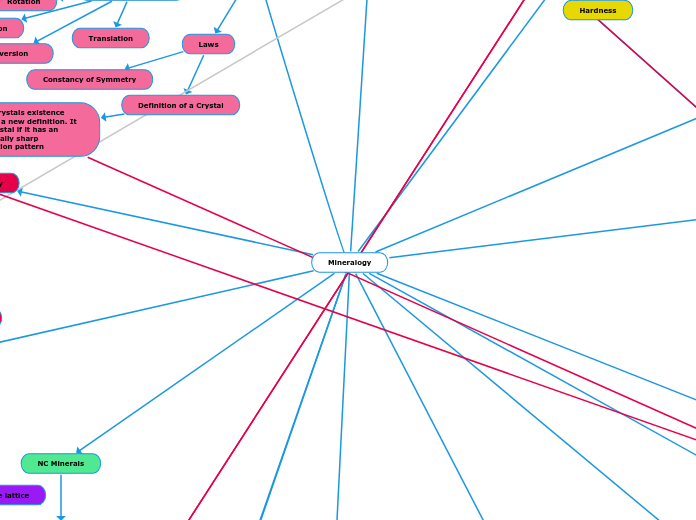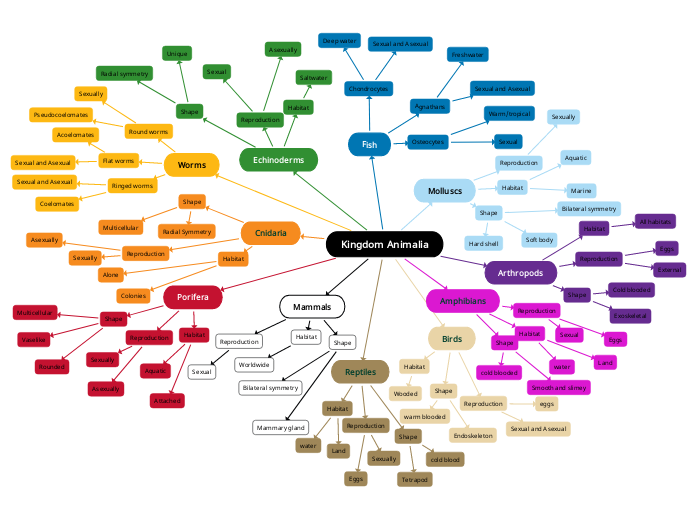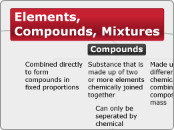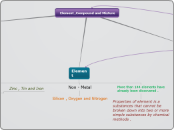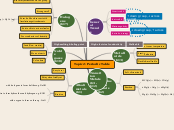Solid Solutions have Zonation
Opposites
Gray Line = Phylogeny
Green Line = Contrast
Blue Line = Expanding Concept
Red Line = Direct Concept Connection
Yellow Line = Hierarchy
Very High Symmetry
High Symmetry
Low Symmetry
Groups divided into Families
Families Divided into Systems
Mineralogy
Representation
Haüy’s law - all crystal faces make intercepts on the
crystallographic axes
Miller Indices - Notation system for planes in lattices - h,k,l used
Can use the miller indices to make stereographic projections
Extraterrestial
Pseudometeorites
Because of the value of meteorites, it is an attractive idea to construct lookalikes that can look comparable on occasion
Extraterrestrial minerals
Most minerals found in meteorites are also found on Earth, except for kamacite and taenite
Kamacite samples have Neumann lines, which is twinning formed by impact shockwaves
These two minerals form Widmastätten patterns when they are together and experience slow cooling
Inclusions in the patterns are Troilite nodules. Black FeS inclusions
These patterns are alternating bands of kamacite and taenite
Plessite - a fine-grained mixture of kamacite and taenite forms last and fills in the gaps
Gemology
Synthetic Gems
Simulants are gemstones that look like another gem, but are made of another substance. Easy to identify because all properties could be different
Growth Processes
Vapor Phase Growth
Uses chemical vapor deposiition and sublimation. commonly used to make diamonds in a high cost, but high speed process
Solution Growth
Simulate natural conditions for gems that melt incongruently, and it has a low yield for a high cost
Melt Growth
Uses congruent melting, and yields a high volume for a low cost
Difficult to distinguish, as chemical, physical, and optical
properties are the same
Treatment
Enhance color and clarity
Filling
Easy to detect, but can make the gem look more smooth
Heat treatment
Changes color of the gem and is irreversible
Natural Gemstones
Semi-precious stones
Every other stone
Precious stones
Sapphire
Ruby
Emerald
Diamond
4 C's
Clarity
I3 - most inclusions
FL - no inclusions (flawless)
Z - Most yellow
D - most clear
Carat
Mass
1 ct = 0.2 g
1 pt = 0.001 ct
Cut
Shape and style of how the gem was cut
Contemporary Mineralogy
Mineral Natural Kinds
A way to group and split mineral species
Mineral Network
Networks provide a valuable way to visualize the distribution and variation of minerals and their properties
Mineral Evolution
Study of diversity and distribution over Earth's 4.5 billion year history
Shows the co-evolution of the geosphere and the biosphere
Mineral Ecology
study of the diversity and spatial distribution of mineral species
on Earth and other terrestrial planets
helps to predict the occurrence and location of mineral species
Systematics
Silicates
Tectosilicates
Tetrahedral network - SiO2
Phyllosilicate
Sheet - Si2O5
Inosilicate
Double Chain - Si4O11
Single Chain - Si2O6
Cyclosilicate
Tetrahedral Ring - Si6O18
Sorosilicate
Double tetrahedra - Si2O7
Nesosilicate
Isolated tetrahedron - SiO4
Nonsilicates
Phosphates
PO4 anion
Carbonates
CO3 anion
Sulfates
SO4 anion
Sulfides
Semi-metals bonded with S
Metals bonded with S
Halide
Ionic bonds
Hydroxide
Metal bonded with OH
Oxides
Semi-metal
Metal
Native Elements
Non-metals
Semi-Metals
Metals
Optical Mineralogy
Optical Indicatrix
Interference Figures
Low Birefringence - Lack of color like quartz
High Birefringence - Color on edges like calcite
Optical Classes
Anisotropic
Biaxial
Trichroic
Uniaxial
Dichroic
Isotropic
Always extinct
Optical Properties
Conoscopic
Cross Polarized for interference figures
Orthoscopic Illumination
Cross Polarized
Birefringence
Extinction
Zonation
Optical Twinning
Plane Polarized
Color and Pleochroism
Relief Lines
Refraction Indices
Crystallochemistry
Isomorphism
If two minerals are isomorphs, and have the same anionic group, they can form solid solutions
Omission
Interstitial
Substitution
Coupled
Simple
Same crystalline structure, different composition
Polymorphism
Polytypism
Order-Disorder
Displacive
Reconstructive
Same Composition, different crystalline structure
Chemical Bonds
Heterodesmic - Multiple Bonds
Homodesmic - One Bond
Metallic
Covalent
Ionic
Crystallography
Crystal Groups
Trimetric a = b = c
Dimetric a = b ≠ c
Monometric a ≠ b ≠ c
Crystal Families
Orthorhombic
Crystal Systems
Isometric
Hexagonal
Trigonal
Tetragonal
Orthrohombic
Monoclinic
Triclinic
Unit Cell
Lattice Systems
Bravais Lattices
Point Groups
Define Crystal Classes. Found by combing 14 unit cells with 4 centering types - 32 possible after redundancies
Non-centrosymmetric
Neither
Polar Enantiomorphic
Enantiomorphic
Polar
Centrosymmetric
inversion center present
Space Groups
Found by combining Point groups and Bravais lattices and screw, glide. Unit cells and all symmetry operations - 230 space groups.
Define a crystalline arrangement and its (finite) frontiers
Found by combining 4 centering types with 7 lattice systems - 14 possible after redundancies
Centering Types
Face-centered
Body-centered
Base-centered
Primitive
Ranked by most Symmetry
1. Isometric
2. Hexagonal
3. Rhombohedral
4. Tetragonal
5. Orthorhombic
6. Monoclinic
7. Triclinic
Smallest repeating unit of the lattice
Morphology
Crystal Forms
Twinning
Polysynthetic
Parallel Association
Cyclic Twinning
Form Quality
Hierarchy of Forms
Euhedral
Subhedral
Anhedral
Closed Forms
Dodecahedra
Octahedra
Disphenoids
Tetrahedra
Scalenohedra
Trapezohedra
Dipyramids
Open Forms
(Di)___Pyramids
Prisms
Pinacoids
Pedions
Constancy of interfacial angles
Bravais Principle
Techniques
Petrographic Microscope
X-Ray Microscope
XRD
Full Spectrum
Monochromatic
Powder
Crystal
Electron Micrscope
TEM
EMPA
Back Scattered Electrons
Scanning Electron Microscope
Symmetry
Laws
Definition of a Crystal
Quasicrystals existence lead to a new definition. It is a crystal if it has an essentially sharp diffraction pattern
Constancy of Symmetry
Symmetry Elements
n-fold rotation
Centers of Symmetry
Mirror Planes
Complex Operations
Screw Rotation
Glide Reflection
Rotoinversion
Simple Operations
Inversion
Rotation
Reflection
Translation
Physical Properties
Piezoelectricity
Tenacity
Fracture
Cleavage
Hardness
Specific Gravity
Habit
Interaction with light
Diaphaneity
Luster
Color
Allochromatic
Idiochromatic
NC Minerals
Mining
Common Minerals and Gems
Olivine
Mica
Lithium (Spodumene)
Garnet
Quartz
State Gem Emerald
Historical
Discovery of Gold
Mineral Research Laboratory
